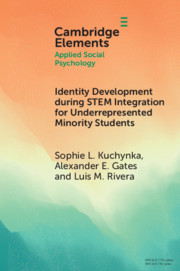Element contents
Identity Development during STEM Integration for Underrepresented Minority Students
Published online by Cambridge University Press: 29 October 2020
Summary
Keywords
Information
- Type
- Element
- Information
- Online ISBN: 9781108882071Publisher: Cambridge University PressPrint publication: 26 November 2020
References
Accessibility standard: Unknown
Why this information is here
This section outlines the accessibility features of this content - including support for screen readers, full keyboard navigation and high-contrast display options. This may not be relevant for you.Accessibility Information
- 13
- Cited by
